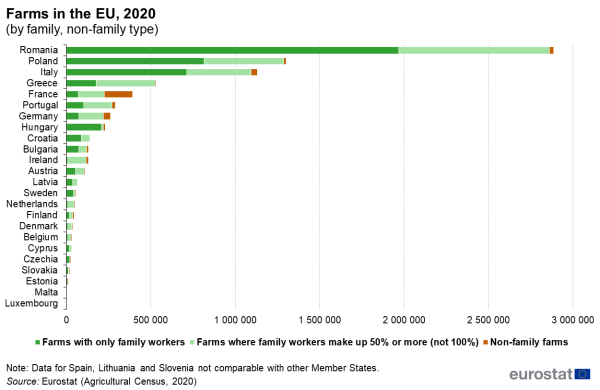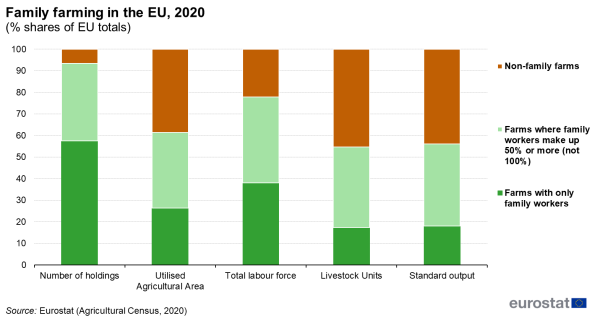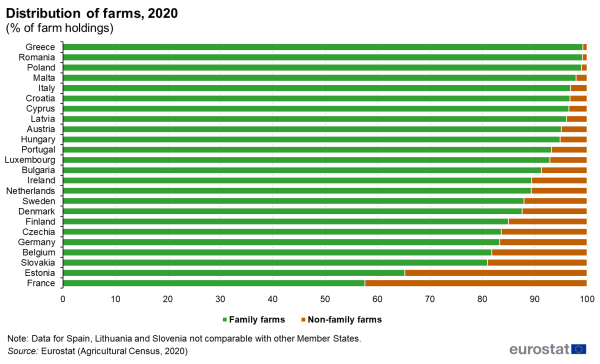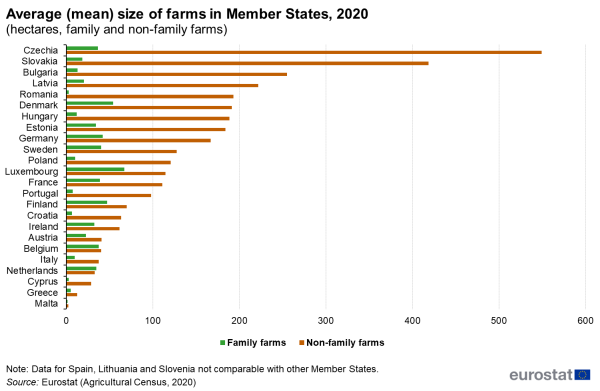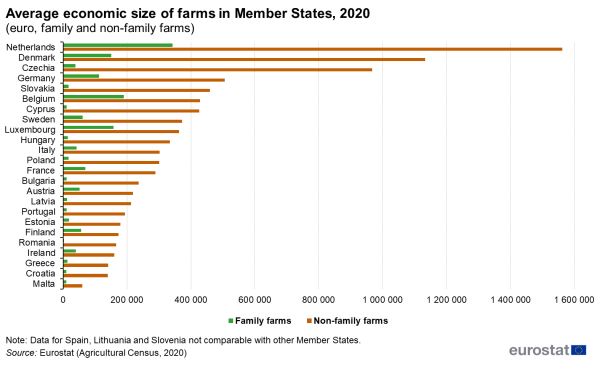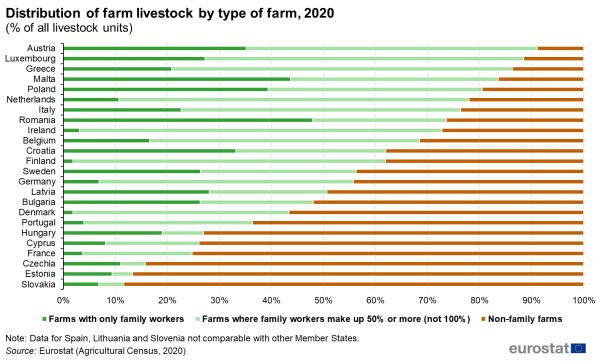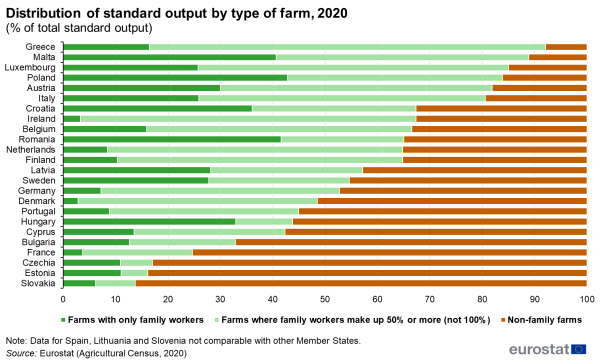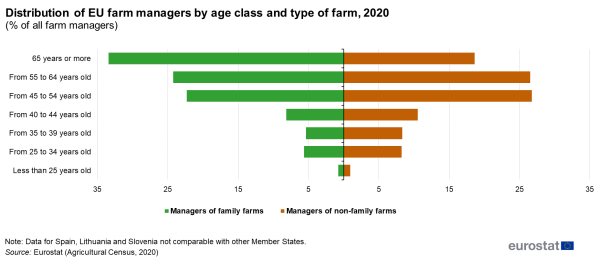Agriculture statistics - family farming in the EU
Data extracted in October 2023.
Planned article update: October 2024.
Highlights
The United Nations' Food and Agriculture Organisation (FAO) defines a family farm as … an agricultural holding which is managed and operated by a household and where farm labour is largely supplied by that household. Family farms are by far the most common type of farm in the European Union (EU), encompassing a wide range of agricultural holdings (hereafter referred to as farms): from small, semi-subsistence farms with only family workers and farms which have to rely on other gainful activities for a diversified source of income, through to much larger, more productive farms which nevertheless are mostly managed by family members.
This article analyses the importance of family farming, the prevalence of family farms in the different Member States and the age and aging of the managers of family farms across the EU. It presents data from the most recent farm structure survey (FSS).
Full article
Structural profile of farms - analysis for the EU
Family farms account for slightly more than 9 in every 10 farms in the EU
There were 9.1 million farms in the EU in 2020, the vast majority of which (an estimated 93 %) can be classified as family farms that operate as family-run businesses in which the farm is passed down through the generations. Indeed, family farms dominate the structure of EU agriculture in terms of their numbers, their contribution to agricultural employment and, to a lesser degree, the area of land that they cultivate and the value of the output they generate.
Based on the FAO's working definition, the term 'family farm' in this article is hereafter used to refer to any farm under family management where 50 % or more of the agricultural labour force was provided by family workers. In other words, a family farm is operated by a household, where the labour supplied is largely from that household. A more detailed division can be made between those farms where labour was provided exclusively by the family (farms with only family workers) and those where 50 % or more (but not 100 %) of the labour force were family workers.
Just under six in every ten farms (about 57 %) in the EU were farmed completely by the holder and family members. Family labour on a further 36 % of all farms accounted for at least one half of all labour on the farm. Non-family farms accounted for just 7 % of all farms in the EU in 2020 (see Figure 1). These shares are little changed from those derived from the Agricultural Census in 2010.
The characterisation of agriculture in the EU as still being founded on family farms is further supported by their shares of a number of key land, labour, capital and economic variables; they accounted for a majority of the utilised agricultural area (UAA) in 2020 (about 61 % of the 157.4 million hectares used), a majority of the total agricultural labour force (about 78 %), a majority of livestock units (about 55 %) and standard output (about 56 %).
Non-family farms account for disproportionately high share of land, labour, capital and economic output
Even though non-family farms only accounted for about 7 % of all farms in the EU in 2020, they accounted for much higher shares of the amount of land used for agricultural production (about 39 %), of the total labour force (about 22 %), of livestock units (about 45 %) and of standard output (about 44 %).
Family farms: many but relatively small
Although far more common in the EU, family farms were consistently smaller than non-family farms. Non-family farms tended to be larger than family farms in terms of the average amount of land used for agricultural production and, as a result, the average amount of livestock held per farm, the average size of the labour force and the economic size of the farm.
The average (mean) size of a farm in the EU was about 17 hectares (ha) in 2020. However, this average masks considerable differences, not least between family farms (an average of about 11 ha) and non-family farms (an average of about 102 ha). Underlining this apparent dichotomy in the structure of farming in the EU, non-family farms had an average of about 85 more livestock units than family farms with only family labour, engaged another three-people full-time on average and had an economic output that was about twenty times higher than family farms that only had family workers (see Figure 2).
Family farms: sharp decline in numbers but changing composition
The number of farms in the EU has been in sharp decline for a number of years: between 2010 and 2020, the EU lost about 3 million farms, almost all of which were family farms (see article farms and farmland in the EU). Of the remaining family farms, there has been an apparent shift away from farms with only family workers towards farms where family workers make up more than 50 % (but not 100 %) of the labour; the share of farms with only family workers decreased by about 6 percentage points, whereas those where family workers make up 50 % or more (but not 100 %) of the labour increased by about 8 percentage points. So whilst family farms still dominate the working landscape of farming in the EU, the number of family farms that rely solely on family workers has declined particularly fast.
Structural profile of farms - analysis of EU Member States
Majority of farms are family farms in all Member States
Of the 9.1 million farms in the EU in 2020, just under one third (31.8 %) were in Romania (see Figure 2 of the article on farms and farmland in the EU), with more than one tenth also in each of Poland (14.4 %), Italy (12.5 %) and Spain (10.1 %).
Family farms accounted for at least 80 % of all farms in all but two of the EU's Member States in 2020 (see Figure 3); the exceptions were Estonia (about 65 %) and France (about 58 %), where the share of non-family farms in all farms was sharply higher than in 2010.
Average size of family farms much smaller than non-family farms in most Member States
Family farms were typically much smaller than non-family farms in terms of their utilised agricultural area (see Figure 4), with the exception of Belgium and the Netherlands where there was little difference in 2020. The differences were starkest in Czechia, where the average size of a non-family farm was about 550 hectares, compared with 37 ha for a family farm.
This was also the case in economic terms (see Figure 5). For example in Romania, the average economic output of a family farm was EUR 2 750 in 2020 compared with an average EUR 165 456 for non-family farms, suggesting that many family farms in Romania should be considered as subsistence farms.
A majority of the agricultural labour used on farms for agricultural activities was carried out on family farms
A clear majority of the labour used on farms for agricultural activities was carried out on family farms in most but not all Member States; only in Estonia (42 %), France (40 %), Czechia (34 %) and Slovakia (29 %) was this not the case (see Figure 6).
A majority of livestock were reared on family farms in most Member States, but notable exceptions
Family farms reared a majority of livestock in most Member States and over 80 % in Austria, Luxembourg, Greece and Malta (see Figure 7). In stark contrast, less than 25 % of livestock were reared on family farms in Slovakia, Estonia and Czechia.
A majority of economic output was generated by family farms in most Member States, but again notable exceptions
One of the crucial issues in farming is the top-heavy age structure (or inverted age pyramid) of farm managers (see the Statistics Explained article on farmers and the agricultural labour force).
Family farms also accounted for the vast majority of the value of agricultural output produced by the agricultural sector in many Member States (the EU average being about 56 %). Indeed, family farms generated more than 80 % of the standard output from agriculture in Greece, Malta, Luxembourg Poland and Austria (see Figure 8). However, family farms generated less than 25 % of the standard output from agriculture in Slovakia, Estonia, Czechia and France.
Farm managers by age
One third of farm managers in the EU (most of whom were family farm managers) were aged 65 years or over in 2020
One of the crucial issues in farming is the top-heavy age structure (or inverted age pyramid) of farm managers (see the Statistics Explained article on farmers and the agricultural labour force).
One third of managers of family farms in the EU (33.5 %) were aged 65 years or more in 2020 and a majority (57.8 %) were aged 55 years or more (see Figure 9). Only 6.5 % of managers of family farms were under 35 years old in 2020 and this share has fallen over time (down from 7.5 % in 2010). Such a high proportion of farmers over 65 years old raises questions about family farm succession in the EU, obstacles for new entrants, the attractiveness of farming as a profession and, ultimately, food security.
The age structure of managers of non-family farms was a little different, with a small majority (53 %) in the age bracket of 45 years to 64 years. However, the issue of getting young people into farming remains; only 9 % of managers of non-family farms were under 35 years old.
Source data for tables and graphs
Data sources
The statistics used in this article come from the results of Agricultural Censuses of 2020 and 2010.
Key indicators and concepts
Using data from the Agricultural Census, and applying the FAO definition for family farms at an operational level, it is possible to analyse farms on the basis of their labour input.
Family farms may be defined as:
- farms with exclusively family labour;
- farms that have predominately family labour (at least 50 % of the agricultural labour force).
By contrast, non-family farms are defined as:
- farms with predominantly non-family labour (at least 50 % of the agricultural labour force);
- farms without any family labour.
Labour force data are provided in terms of a simple count of the number of persons as well as being converted into annual work units. Due to the high share of seasonal and part-time work in agriculture, it is generally considered appropriate to assess labour input using data presented in annual work units. One annual work unit corresponds to the work performed by one person who is occupied on a farm on a full-time basis for a full year. Full-time means the minimum hours required by the national provisions governing contracts of employment. If these provisions do not explicitly indicate the number of hours, then 1 800 hours are taken to be the minimum (225 working days of eight hours each).
Utilised agricultural area is the total area taken by arable land, permanent grassland, permanent crops and kitchen gardens used by the holding, regardless of the type of tenure or of whether it is used as a part of common land.
A livestock unit is a reference unit which facilitates the aggregation of livestock from various species and age, through the use of specific coefficients established initially on the basis of the nutritional or feed requirement of each type of animal (with a set of coefficients for 23 different categories of animal). The reference unit used for the calculation of livestock units is one adult dairy cow. For example, a single livestock unit corresponds to 10 sheep or goats.
The standard output of an agricultural product (crop or livestock) is the average monetary value of the agricultural output at farm-gate price, in euro per hectare or per head of livestock. There is a regional standard output coefficient for each product, as an average value over a reference period (5 years, except for the standard output 2004 coefficient calculated using the average of 3 years). The sum of all the standard output per hectare of crop and per head of livestock in a farm is a measure of its overall economic size, expressed in euro. The standard output is used to classify agricultural holdings by type of farming and by economic size.
The data for 2020 that are detailed in this article are based on farms under the main frame and the frame extension of the Agricultural Census 2020. Note that in 2020 not all countries provided frame extension data for the module on labour force (namely Spain, Slovenia and Lithuania). This is in line with current regulation but limits the comparability across all countries. Please refer to the IFS handbook for further information on the coverage and limitations in comparability for 2020 agricultural census data.
Context
Family farming
The FAO [[1]] declared 2014 to be the International year of family farming. As a follow-up to this initiative, the Family Farming Knowledge Platform was created. It gathers information on family farming from all over the world, including national laws and regulations, public policies, best practices, relevant data and statistics, research, articles and publications.
More recently, in 2017, the General Assembly of the United Nations adopted a resolution which proclaimed the United Nations Decade of Family Farming for the period 2019-2028. Its main objective is to support family farms through a Global Action Plan, which consists of seven pillars of work containing measures on a local and global level.
EU support to family farms through the common agricultural policy (CAP) has also been explicit in the period 2014–2020. The small farmers' scheme has been part of the post-2013 CAP reforms, providing small farmers with the opportunity to reduce red tape and accept a one-off, lump-sum payment to replace all direct payments. The CAP reforms for 2014–2020 have also promoted greater integration with regional and structural funds. It includes the possibility for small family farmers to receive business start-up aid, with young farmers being eligible for a combination of measures including start-up grants, training and advisory services. All these efforts are designed to support the development of family farming, especially on a smaller (though commercial) scale. This support should continue under the new Green Deal and should go some way to curbing the loss of family farms.
Benefits of family farming
According to FAO family farming preserves traditional food products, while contributing to a balanced diet and safeguarding the world's agro-biodiversity and the sustainable use of natural resources. At the same time it also represents an opportunity to boost local economies, especially when combined with specific policies aimed at the social protection and well-being of communities.
Challenges for family farmers
The main challenges facing family farms often reflect issues that are common for all types of small business: access to resources (such as land and capital) or access to markets (particularly in relation to the bargaining power of small farms in the food chain). Demographics provide a social challenge for family farms, as inter-generational succession issues may impact upon the sustainability of family farming. This challenge is further complicated in some of the EU Member States by legislation over inheritance (which may influence land consolidation/fragmentation).
Direct access to
- agriculture, see:
- Farm structure (ef)
- Key figures on the European food chain – 2022 edition
- Key figures on the European food chain – 2021 edition
- Farm structure (SIMS metadata file — ef_sims)
- Farm structure survey (FSS) (background article)
- Regulation (EC) No 1166/2008 on farm structure surveys and the survey on agricultural production methods
- Regulation (EC) No 1200/2009 implementing Regulation (EC) No 1166/2008 on farm structure surveys and the survey on agricultural production methods, as regards livestock unit coefficients and definitions of characteristics
- Farm to Fork strategy
- European Green Deal
- European Commission — Common Agricultural Policy after 2013
- European Commission — Family farming: a dialogue towards more sustainable and resilient farming in Europe and the world
- European Commission — Rural Development Policy 2014–2020
- United Nations (FAO) — International Year of Family Farming
- United Nations (FAO) — Family Farming Knowledge Platform
